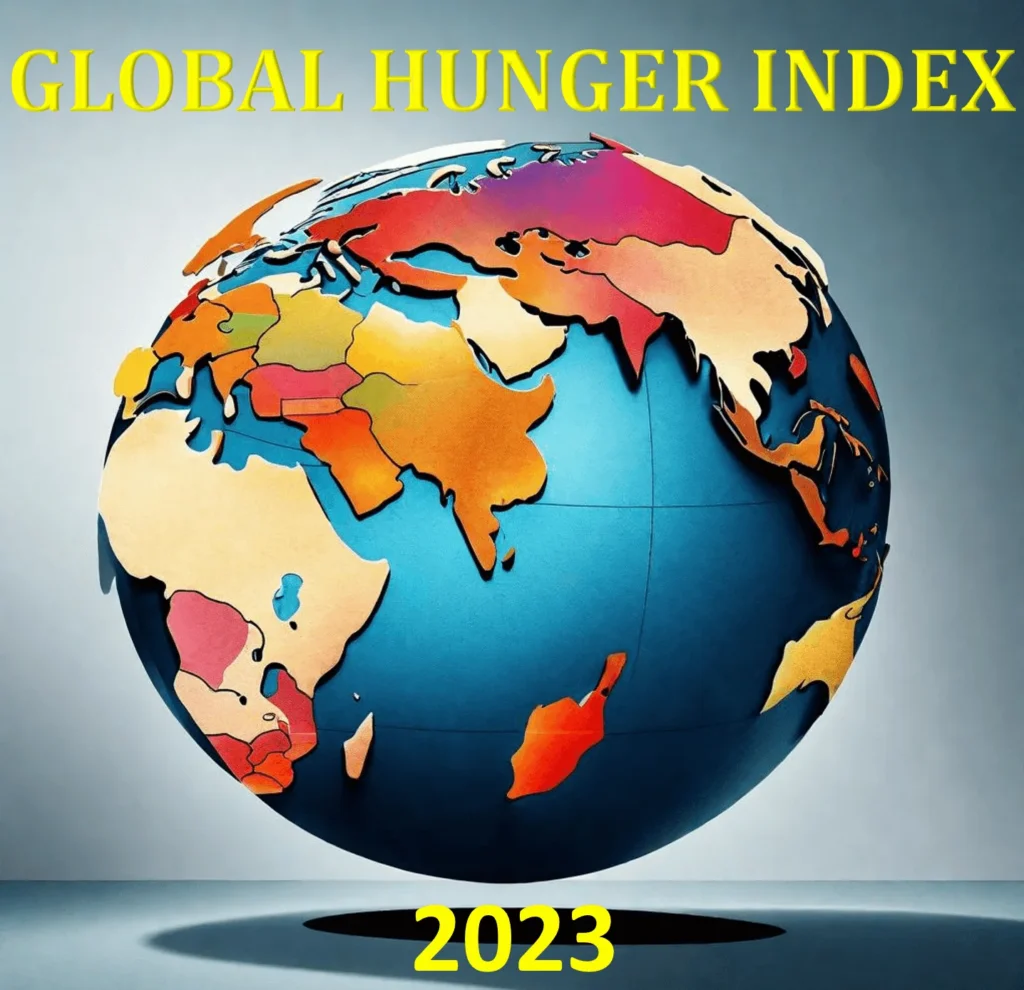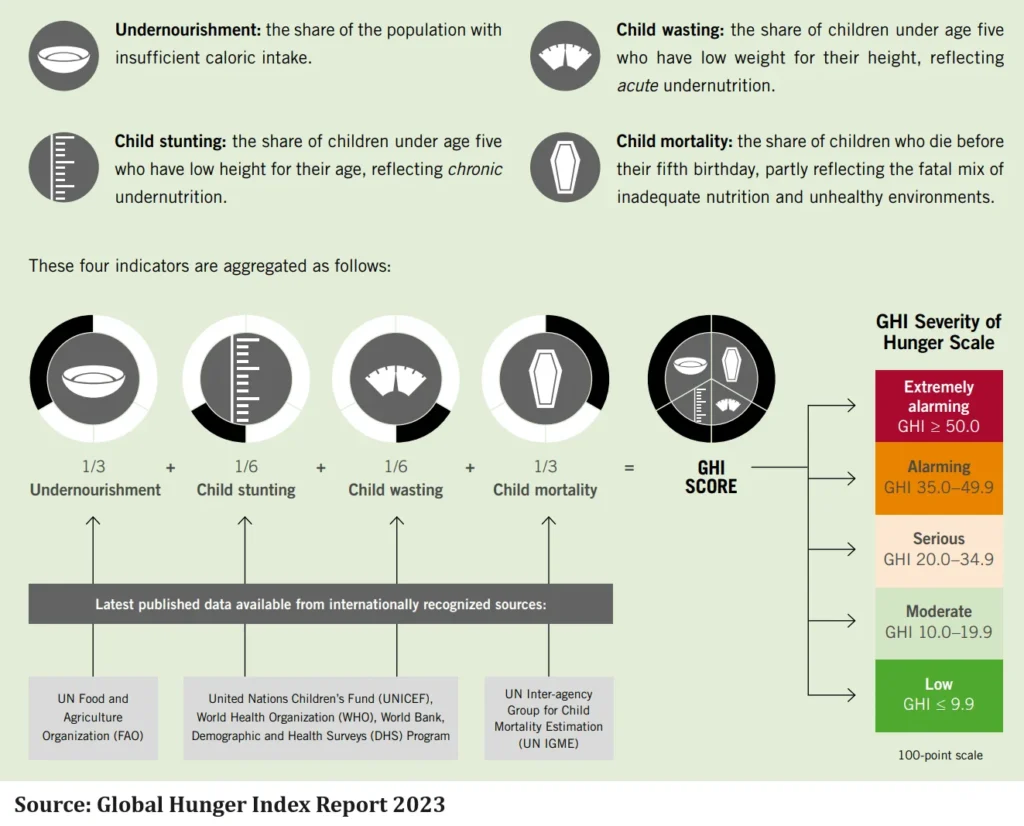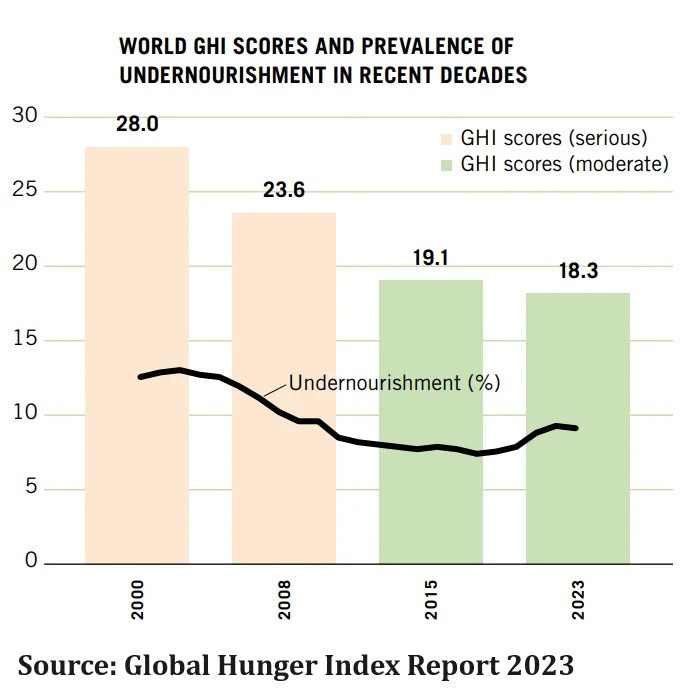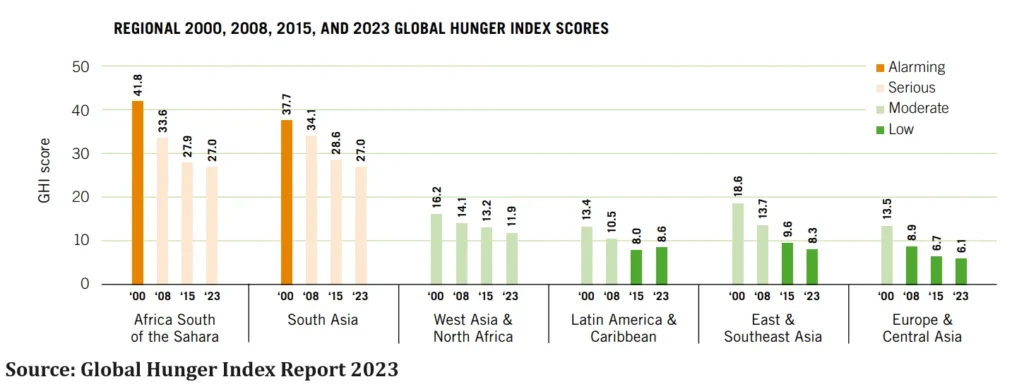
The Global Hunger Index (GHI) is a crucial tool for comprehending the critical state of hunger in the globe. The GHI illuminates the alarming levels of food insecurity afflicting the world through its thorough analysis and thorough research. It supports the implementation of successful strategies to address hunger and offers politicians, organizations, and people important insights into the pressing issue of hunger.
Brief overview of hunger as a global issue
Millions of people are impacted by hunger, a pernicious worldwide problem that has existed for ages. Often, we make mistake by associating hunger with lack of food to eat. However, it is the root cause to the big tangle of problems. This tangle includes things like unfairness, bad roads and buildings, being very poor, and fighting. These things make hunger worse. Hunger doesn’t just make your stomach empty; it also makes your body and feelings not good, and it makes it hard for you to get better and escape from being poor. Plus, hunger makes it tough to concentrate and do your work.
Historical Perspective of the Global Hunger Index
Origins and evolution of the Global Hunger Index
The Global Hunger Index (GHI) was designed with the aim to address the biggest problem of human civilization i.e., Hunger. All this started in 2006 by bringing together US based International Food Policy Research Institute (IFPRI) and German NGO Welt Hunger Hilfe. Later in 2007 it was joined by Irish NGO Concern Worldwide. Over time, the GHI became a strong and famous tool. It helps us see how much hunger there is all around the world and gives smart information to help make better decisions and actions.
Major milestones and changes over the years
The Global Hunger Index has undergone substantial adjustments since it was first created in order to improve its precision and thoroughness. The GHI has been able to capture a more nuanced knowledge of global hunger because to the addition of new indicators, improvements in methodology, and the incorporation of more data. Because of these advancements, stakeholders and policymakers now have a better understanding of the problems at hand and can decide how best to solve them.
Methodology and Components of GHI
Explanation of the methodology used to calculate the GHI
The Global Hunger Index employs a rigorous methodology to accurately assess and quantify hunger levels worldwide. The GHI integrates four key indicators: undernourishment, child wasting, child stunting, and child mortality. Each indicator is carefully selected to capture different dimensions of hunger, providing a comprehensive evaluation of a country’s food security situation.

Factors and indicators considered in the GHI assessment
The GHI considers a number of elements that influence the occurrence of hunger in its evaluation. These factors are important in understanding hunger: having enough food, being healthy, having hospitals and clinics, not being very poor, going to school, and having a peaceful government. The GHI looks at many signs to give a full picture of why hunger happens and what it leads to. This helps leaders and people involved make plans that work for specific problems.
Global Hunger Index 2023: Key Findings
An overview of the latest Global Hunger Index report
The Global Hunger Index 2023 report unveils a grim reality for millions around the world. It demonstrates how widespread food insecurity persists as a serious issue in many nations. The study paints a complete picture of how dire the hunger situation is worldwide and makes it clear that action must be taken right away.

Highlighting the overall global hunger levels
The report indicates that despite some progress, hunger remains prevalent across the globe. Millions of people continue to face the anguish of food scarcity daily. The GHI 2023 report underscores the necessity of collective efforts to combat hunger, as it reveals that substantial disparities persist, with certain regions and countries bearing a disproportionately heavy burden.
Regional Analysis: The Hidden Hunger Hotspots
Focus on countries with the highest hunger levels!
Within the global hunger landscape, certain regions and countries emerge as hotspots, grappling with the highest levels of hunger. The GHI 2023 report delves into these deeply affected regions, shedding light on the immense challenges they face. From sub-Saharan Africa to Eastern Asia, the report explores the harrowing reality of hunger in these areas and underscores the urgent need for targeted interventions.

Analyzing regional disparities and their implications
The regional disparities in hunger levels expose the systemic inequalities that perpetuate food insecurity. The GHI 2023 report emphasizes the need to address the root causes of these disparities to achieve lasting solutions. By disentangling the complex web of social, economic, and political factors, we can gain valuable insights into the implications of these disparities and pave the way for more equitable and sustainable solutions.
Alarming Hunger Scenarios in Africa
In-depth exploration of hunger challenges in Africa
Africa, as one of the most afflicted continents, is plagued by severe hunger challenges. The GHI 2023 report highlights the alarming scenarios that persist in various African nations. Factors such as conflict, poverty, climate change, and inadequate infrastructure converge to exacerbate hunger levels, endangering the lives of countless individuals. It is imperative to delve into these challenges and formulate targeted strategies to alleviate suffering and build resilience.
Addressing root causes and potential solutions
To combat hunger effectively in Africa, it is crucial to address the underlying causes that perpetuate food insecurity. Comprehensive strategies that tackle poverty, conflicts, limited access to education and healthcare, and support sustainable agriculture are vital. By investing in social safety nets, empowering local communities, promoting gender equality, and fostering international cooperation, countries can create lasting solutions and uplift millions from the grips of hunger.
Asia’s Battle against Hunger
Examination of hunger issues in Asia
Asia, being home to a significant portion of the world’s population, faces its own battles against hunger. The GHI 2023 report sheds light on the specific challenges prevalent in this diverse continent. From chronic malnutrition in certain areas to rapid urbanization impacting food security, Asia grapples with a multitude of issues that demand immediate attention and tailored solutions.
Success stories and persistent challenges
Despite the challenges, Asia has witnessed significant progress in combating hunger. Success stories emerge from countries that have prioritized food security, invested in innovative agriculture practices, implemented social welfare programs, and fostered cross-sector collaborations. However, persistent challenges remain, particularly in regions with fragile political systems, ongoing conflicts, or marginalized populations. Efforts must be made to build upon successes and address the persistent challenges to ensure a hunger-free Asia.
India slipping down four positions
India, often referred to as the world’s largest democracy, has recently faced setbacks in its battle against hunger. The GHI 2023 report reveals India’s slip by four positions in the index, reflecting the challenges it faces in ensuring food security for all. The study underscores how crucial it is to work even harder and concentrate on particular efforts to reduce hunger in our nation. India ranked 111st out of 125 countries in the GHI 2023, which was released on Thursday. India’s score is 28.7. In 2022, India ranked 107th out of 121. However, our neighboring countries Pakistan, Bangladesh, Nepal, and Sri Lanka were ranked 102nd, 81st, 69th, and 60th respectively in the same index.
The Americas: Tackling Hunger in a Developed Context
Unique aspects of hunger in North and South America
While often considered prosperous regions, North and South America still grapple with their own unique challenges of hunger. In the context of these developed regions, hunger takes on different dimensions, influenced by socioeconomic factors, urbanization, and regional disparities. By understanding the specific nuances of hunger in the Americas, tailored strategies can be devised to address food insecurity effectively.
Socioeconomic factors influencing hunger
Socioeconomic condition forms an important factor for hunger in North and South America. Social injustices, financial disparities, and a lack of access to healthcare and education all contribute to the persistence of food insecurity. These disparities must be closed in order to give disadvantaged groups equitable opportunity for development and access to wholesome food.
Europe’s Hidden Struggle with Hunger
Shedding light on often overlooked hunger issues in Europe
Europe, often associated with affluence and abundance, faces its own hidden struggle with hunger. The GHI 2023 report draws attention to the regions within Europe that are plagued by food insecurity. Factors such as migration, poverty, and climate change pose unique challenges, and it is essential to identify and address these specific dynamics to eradicate hunger on the continent.
Role of migration, poverty, and climate change
Migration patterns in Europe have resulted in a diverse population with varied needs, including access to food. Poverty, often driven by systemic inequalities and social exclusion, acts as a significant barrier to food security in certain European regions. Climate change further exacerbates these challenges, impacting agricultural practices and increasing vulnerability to food insecurity. A holistic approach that considers all these factors is crucial in addressing Europe’s hidden struggle with hunger.
Oceania: Addressing Hunger in Remote Island Nations
Understanding hunger challenges in Pacific Island nations
Oceania, encompassing numerous remote island nations, faces distinct and critical challenges in combating hunger. The GHI 2023 report sheds light on the specific barriers faced by countries in this region, including limited resources, geographical isolation, and climate change impacts. Understanding these challenges is crucial to developing sustainable strategies that cater to the unique needs of Pacific Island nations.
Efforts towards sustainability and resilience
Oceania has undertaken inspiring efforts towards achieving food security and resilience in the face of adversities. These efforts involve sustainable agriculture practices, community-based initiatives, and collaborations with international and regional organizations. By leveraging traditional knowledge, fostering innovation, and emphasizing the importance of local ownership, Oceania can progressively address hunger and create a path towards a sustainable future.
Conflict Zones: Hunger as a Consequence of Warfare
Examining the interplay between conflict and hunger
Conflict-ridden regions often experience the harshest consequences of hunger. The GHI 2023 report highlights the devastating interplay between conflict and food security, as the two perpetuate and reinforce each other in a vicious cycle. It is essential to recognize the impacts of conflict on food systems, displacement, and the disruption of livelihoods to effectively combat hunger in conflict zones.
Case studies of conflict-affected regions
In order to underscore the terrifying realities experienced by people caught in the crossfire, the research presents case studies of conflict-affected areas including Yemen, South Sudan, and Syria. In order to break the cycle of violence and hunger, it highlights the urgent need for humanitarian help, political initiatives, and long-term plans. It reveals the complex mechanisms that cause severe hunger in these regions.
Climate Change and Hunger
Climate change’s effects on food security
Climate change poses a severe danger to world food security. The severe effects of climate change on agricultural production, water availability, and natural resources are highlighted in the GHI 2023 study. Global Warming, erratic weather patterns, and increasing frequency of extreme events severely disrupt food production, exacerbating food insecurity for vulnerable communities worldwide.
Climate adaptation strategies and policy implications
Addressing the menace of climate change requires robust adaptation strategies and policy interventions. The GHI 2023 report highlights successful initiatives that focus on sustainable agricultural practices, promoting climate-resilient crops, enhancing water usage efficiency, and reducing carbon emissions. Scaling up these efforts and integrating climate considerations into broader development agendas is crucial to break the vicious cycle of climate change and hunger.
Gender and Hunger: Dissecting the Disparities
Exploring the gender dimensions of hunger
Hunger disproportionately affects women and girls, and the GHI 2023 report delves into the gender disparities that persist in access to food and nutrition. Discriminatory cultural norms, barriers to education and healthcare, constrained economic opportunities, and limited decision-making power perpetuate the vicious cycle of gender-based food insecurity, demanding comprehensive and gender-transformative approaches.
Women’s empowerment and its role in combating hunger
The empowerment of women and girls emerges as a crucial factor in combating hunger effectively. The GHI 2023 report emphasizes the need for gender-responsive policies, programs, and investments that promote women’s access to resources, education, and decision-making roles. By recognizing and addressing the specific needs and challenges faced by women, societies can unleash their potential as drivers of change and key agents in eradicating hunger.
COVID-19 and the Global Hunger Crisis
Examining the aftermath of the pandemic on hunger levels
The COVID-19 pandemic has wreaked havoc on global food security, exacerbating existing hunger crises and giving rise to new challenges. The GHI 2023 report examines the aftermath of the pandemic, highlighting its detrimental impact on livelihoods, disruptions in food supply chains, and increased vulnerability to food insecurity. It underscores the need for resilient and inclusive systems to address future crises.
Mitigation measures and resilience-building efforts
To mitigate the impact of the global hunger crisis triggered by the pandemic, proactive measures are paramount. The GHI 2023 report showcases successful initiatives that focus on social protection schemes, emergency food aid, investments in small-scale agriculture, and strengthening local food systems. These efforts contribute to building resilience, ensuring access to food, and reducing vulnerability in the face of crises.
Global Efforts to Eradicate Hunger by 2030
Analyzing the Sustainable Development Goal 2 (Zero Hunger)
The Sustainable Development Goal 2 (Zero Hunger) represents a global commitment to end hunger and achieve food security for all by 2030. The GHI 2023 report evaluates progress made towards this goal, acknowledging the achievements, identifying the gaps, and outlining strategies to accelerate progress and transform the lives of millions still suffering from hunger.
Evaluating progress and identifying gaps
The GHI 2023 report evaluates the progress made towards achieving the Sustainable Development Goal 2, illuminating the successes and shortcomings in efforts to end hunger. It identifies critical gaps in policies, funding, and implementation, highlighting the urgency of collective action and targeted interventions to meet the ambitious goal of eradicating hunger by 2030.
Case Study: Successful Hunger Alleviation Models
Highlighting innovative approaches to ending hunger
In the fight against hunger, innovative and successful models have emerged globally. The GHI 2023 report presents notable case studies from various regions, showcasing initiatives that empower communities, promote sustainable agriculture, improve access to education and healthcare, and foster inclusive policies. Emulating and scaling up such models can play a pivotal role in accelerating progress towards a hunger-free world.
Learning from success stories around the world
The GHI 2023 report emphasizes the importance of learning from success stories. By studying the experiences of countries that have made significant advancements in reducing hunger, valuable insights can be gained, informing the design and implementation of effective strategies elsewhere. Collaboration, knowledge-sharing, and adaptability are key to achieving sustainable and lasting hunger alleviation worldwide.
The Role of NGOs and International Organizations
Examining the achievements of international groups and NGOs
The fight against hunger cannot be won without the contribution of international agencies and NGO’s. Their efforts in delivering humanitarian relief, carrying out sustainable development initiatives, developing collaborations, and promoting laws that place a priority on reducing hunger are acknowledged in the GHI 2023 report. Their presence and expertise strengthen the collective efforts towards achieving food security for all.
Collaborative initiatives and their impact on hunger reduction
Through collaborative initiatives, NGOs and international organizations are actively working towards reducing hunger. The GHI 2023 report highlights successful partnerships that leverage diverse expertise, resources, and networks to devise and implement holistic approaches to food security. By uniting efforts, these organizations create a multiplier effect, ensuring more significant impacts and reaching those most in need.
Government Policies and Hunger
Assessing the effectiveness of government policies in combating hunger
Government policies play a pivotal role in combating hunger. The GHI 2023 report critically examines the effectiveness of government policies in addressing food security, evaluating their impact on reducing hunger. It looks into the success stories that demonstrate how well-crafted policies, relevant legislation, and effective governance can bring about tangible changes and uplift communities from the clutches of hunger.
Policy recommendations for more impactful interventions
The GHI 2023 report provides policy recommendations to improve and enhance government interventions in combating hunger. These recommendations include investing in sustainable agriculture practices, adopting social protection schemes, prioritizing nutrition and health programs, and strengthening governance frameworks. By implementing these recommendations, governments can bolster their effectiveness in eradicating hunger and providing a secure future for their citizens.
The Importance of Public Awareness and Advocacy
Engaging individuals and communities in the fight against hunger
To effectively combat hunger, we must first acknowledge its severity and extent. By educating others on the issue, we may help them realize how important it is. Information sharing enables others to understand the challenging circumstances that many people encounter on a daily basis.
Through initiatives like educational campaigns, the use of movies and other media, and neighborhood conversations, we can engage the public. These techniques equip individuals with the information necessary to comprehend the causes of hunger, how it impacts communities that are already struggling, and what can be done to address it. By promoting understanding, we may motivate action and spark a movement that breaks down boundaries and crosses borders.
Promoting advocacy and collective action
Advocacy is a driving force in the fight against global hunger. Advocates are like champions for those who can’t speak up. They use their influence to convince governments, groups, and people to make important promises and changes. They want to make sure that fighting hunger is still something important worldwide.
One cool thing about advocacy is that it can make the stories of people affected by hunger more powerful. By telling these stories, advocates make the issue real for more people. This makes people feel more understanding and want to help, like giving money to groups helping or doing advocacy work themselves.
Working together is also a big part of fighting global hunger. When communities team up and different groups work together, we can join forces to fight this problem that won’t go away. Governments, organizations, and big companies can work together to share resources and knowledge to find solutions that last.
A Final Word
The Global Hunger Index 2023 starkly foregrounds the harsh realities of world hunger, hidden away in isolated corners. As global citizens, we should leverage these insights to fuel our collective actions towards creating a hunger-free world. Let’s remember, feeding the world is more than a challenge; it’s a moral obligation.
The Global Hunger Index serves as a vital compass, directing our focus to the world’s most food-insecure areas. It’s our task – governments, civil society, and individuals – to ensure that the needle moves towards zero hunger. Let the narrative of the Global Hunger Index 2023 not only unmask the extent of worldwide hunger but also galvanize us into decisive action. Because hunger, after all, is not a numbers game; it’s a fight for humanity.
